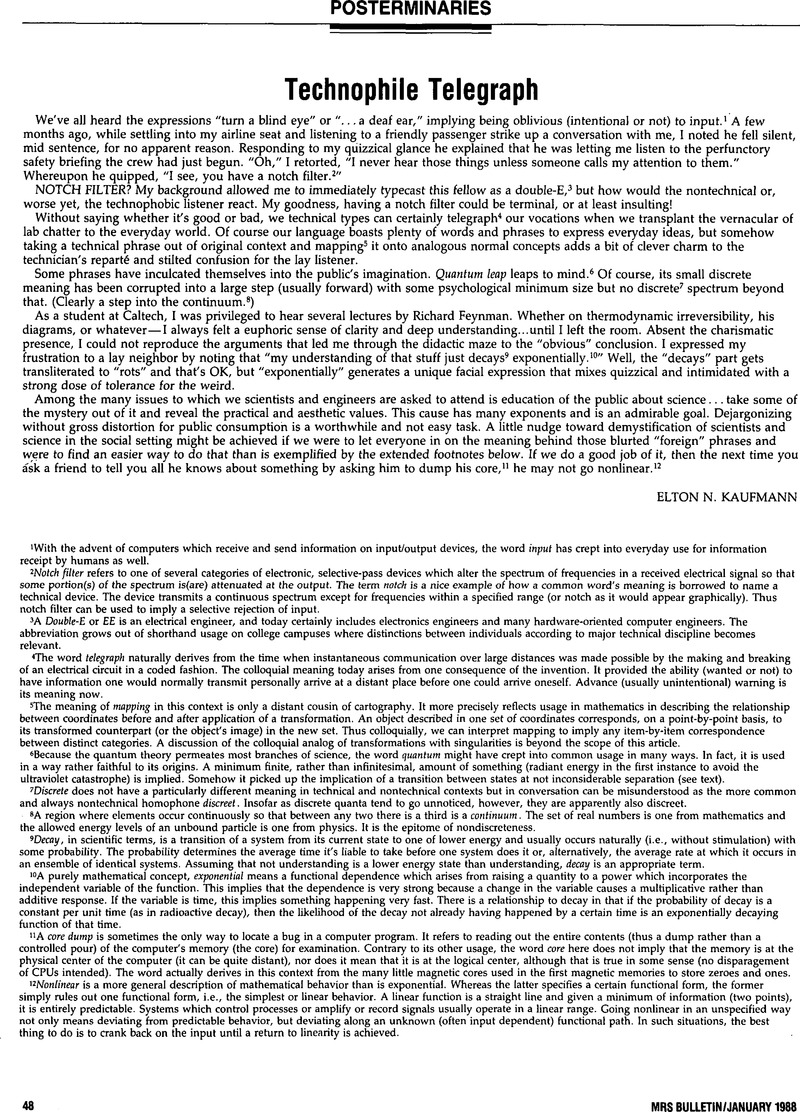No CrossRef data available.
Article contents
Technophile Telegraph
Published online by Cambridge University Press: 29 November 2013
Abstract

Information
- Type
- Departments
- Information
- Copyright
- Copyright © Materials Research Society 1988
References
1 With the advent of computers which receive and send information on input/output devices, the word input has crept into everyday use for information receipt by humans as well.
2 Notch filter refers to one of several categories of electronic, selective-pass devices which alter the spectrum of frequencies in a received electrical signal so that some portion(s) of the spectrum is(are) attenuated at the output. The term notch is a nice example of how a common word's meaning is borrowed to name a technical device. The device transmits a continuous spectrum except for frequencies within a specified range (or notch as it would appear graphically). Thus notch filter can be used to imply a selective rejection of input.
3 A Double-E or EE is an electrical engineer, and today certainly includes electronics engineers and many hardware-oriented computer engineers. The abbreviation grows out of shorthand usage on college campuses where distinctions between individuals according to major technical discipline becomes relevant.
4 The word telegraph naturally derives from the time when instantaneous communication over large distances was made possible by the making and breaking of an electrical circuit in a coded fashion. The colloquial meaning today arises from one consequence of the invention. It provided the ability (wanted or not) to have information one would normally transmit personally arrive at a distant place before one could arrive oneself. Advance (usually unintentional) warning is its meaning now.
5 The meaning of mapping in this context is only a distant cousin of cartography. It more precisely reflects usage in mathematics in describing the relationship between coordinates before and after application of a transformation. An object described in one set of coordinates corresponds, on a point-by-point basis, to its transformed counterpart (or the object's image) in the new set. Thus colloquially, we can interpret mapping to imply any item-by-item correspondence between distinct categories. A discussion of the colloquial analog of transformations with singularities is beyond the scope of this article.
6 Because the quantum theory permeates most branches of science, the word quantum might have crept into common usage in many ways. In fact, it is used in a way rather faithful to its origins. A minimum finite, rather than infinitesimal, amount of something (radiant energy in the first instance to avoid the ultraviolet catastrophe) is implied. Somehow it picked up the implication of a transition between states at not inconsiderable separation (see text).
7 Discrete does not have a particularly different meaning in technical and nontechnical contexts but in conversation can be misunderstood as the more common and always nontechnical homophone discreet. Insofar as discrete quanta tend to go unnoticed, however, they are apparently also discreet.
8 A region where elements occur continuously so that between any two there is a third is a continuum. The set of real numbers is one from mathematics and the allowed energy levels of an unbound particle is one from physics. It is the epitome of nondiscreteness.
9 Decay, in scientific terms, is a transition of a system from its current state to one of lower energy and usually occurs naturally (i.e., without stimulation) with some probability. The probability determines the average time it's liable to take before one system does it or, alternatively, the average rate at which it occurs in an ensemble of identical systems. Assuming that not understanding is a lower energy state than understanding, decay is an appropriate term.
10 A purely mathematical concept, exponential means a functional dependence which arises from raising a quantity to a power which incorporates the independent variable of the function. This implies that the dependence is very strong because a change in the variable causes a multiplicative rather than additive response. If the variable is time, this implies something happening very fast. There is a relationship to decay in that if the probability of decay is a constant per unit time (as in radioactive decay), then the likelihood of the decay not already having happened by a certain time is an exponentially decaying function of that time.
11 A core dump is sometimes the only way to locate a bug in a computer program. It refers to reading out the entire contents (thus a dump rather than a controlled pour) of the computer's memory (the core) for examination. Contrary to its other usage, the word core here does not imply that the memory is at the physical center of the computer (it can be quite distant), nor does it mean that it is at the logical center, although that is true in some sense (no disparagement of CPUs intended). The word actually derives in this context from the many little magnetic cores used in the first magnetic memories to store zeroes and ones.
12 Nonlinear is a more general description of mathematical behavior than is exponential. Whereas the latter specifies a certain functional form, the former simply rules out one functional form, i.e., the simplest or linear behavior. A linear function is a straight line and given a minimum of information (two points), it is entirely predictable. Systems which control processes or amplify or record signals usually operate in a linear range. Going nonlinear in an unspecified way not only means deviating from predictable behavior, but deviating along an unknown (often input dependent) functional path. In such situations, the best thing to do is to crank back on the input until a return to linearity is achieved.

